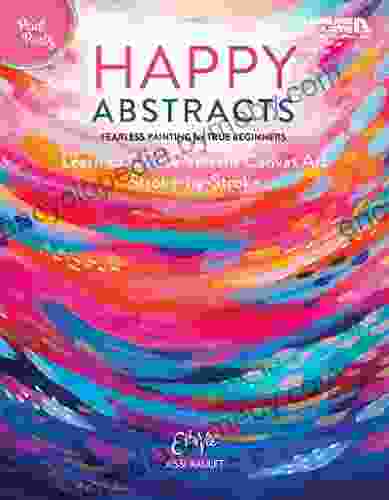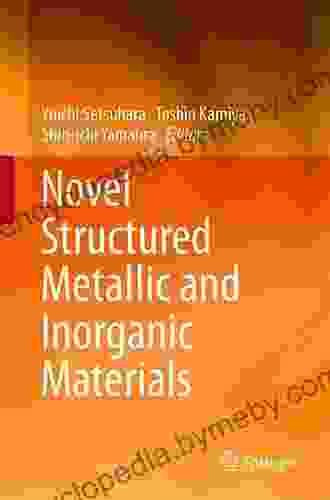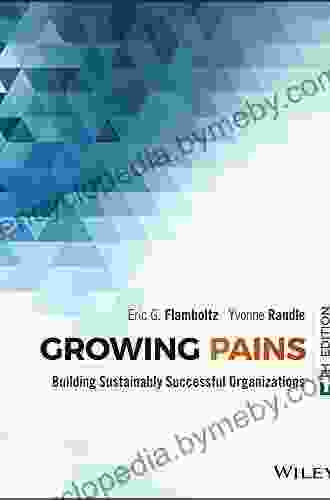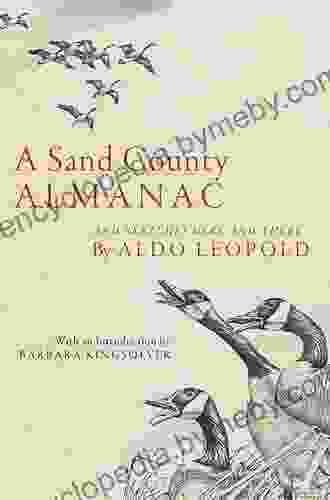Novel Structured Metallic and Inorganic Materials: A Comprehensive Exploration

The world of materials science is constantly evolving, with new discoveries and advancements shaping the way we design and create. Among the most exciting and promising areas of research is the development of novel structured metallic and inorganic materials. These materials possess unique properties and functionalities that open up endless possibilities for technological innovation.
In this comprehensive article, we will delve into the fascinating world of novel structured metallic and inorganic materials. We will explore their synthesis, characterization, properties, and applications, providing a comprehensive overview of this rapidly growing field.
The synthesis of novel structured materials requires specialized techniques and processes. These techniques can be broadly classified into two categories: top-down and bottom-up approaches.
5 out of 5
| Language | : | English |
| File size | : | 123633 KB |
| Text-to-Speech | : | Enabled |
| Screen Reader | : | Supported |
| Enhanced typesetting | : | Enabled |
| Print length | : | 908 pages |
- Top-down approaches: These methods start with a bulk material and break it down into smaller structures. Examples of top-down techniques include mechanical milling, chemical etching, and lithography.
- Bottom-up approaches: These methods build materials from the bottom up, starting with atoms or molecules. Examples of bottom-up techniques include chemical vapor deposition, molecular beam epitaxy, and sol-gel processing.
The choice of synthesis method depends on the desired material properties and the available resources. By carefully controlling the synthesis parameters, researchers can tailor the structure and properties of novel materials to meet specific requirements.
Once synthesized, novel structured materials must be characterized to determine their properties and performance. A wide range of characterization techniques are available, including:
- Electron microscopy: This technique provides high-resolution images of materials, allowing researchers to visualize their structure and morphology.
- X-ray diffraction: This technique uses X-rays to determine the crystal structure of materials.
- Spectroscopy: This technique measures the interaction of light with materials, providing information about their chemical composition and electronic structure.
- Mechanical testing: This technique measures the mechanical properties of materials, such as their strength, hardness, and toughness.
By combining these and other characterization techniques, researchers can gain a comprehensive understanding of the properties and performance of novel structured materials.
Novel structured metallic and inorganic materials possess a wide range of unique properties, including:
- High strength and toughness: These materials can be stronger and tougher than traditional materials, making them ideal for applications in aerospace, automotive, and construction.
- Lightweight: These materials are often lighter than traditional materials, making them suitable for applications where weight is a critical factor.
- High thermal conductivity: These materials can conduct heat very efficiently, making them ideal for applications in electronics and thermal management.
- Low thermal expansion: These materials have a low coefficient of thermal expansion, making them stable and reliable under varying temperature conditions.
- Tunable electrical properties: The electrical properties of these materials can be tailored to meet specific requirements, making them useful for applications in electronics and energy storage.
Due to their unique properties, novel structured metallic and inorganic materials have a wide range of applications, including:
- Aerospace: These materials are used in aircraft and spacecraft structures, engines, and thermal management systems.
- Automotive: These materials are used in lightweight vehicle components, such as body panels and chassis.
- Electronics: These materials are used in semiconductors, capacitors, and other electronic devices.
- Energy storage: These materials are used in batteries, fuel cells, and supercapacitors.
- Biomedical: These materials are used in implants, drug delivery systems, and tissue engineering.
The applications of novel structured metallic and inorganic materials are limited only by the imagination of researchers and engineers. As scientists continue to explore and refine these materials, we can expect to see even more innovative and groundbreaking applications in the future.
Despite their enormous potential, the development of novel structured metallic and inorganic materials faces a number of challenges, including:
- Scalability: Scaling up the synthesis of novel materials from the laboratory to industrial production can be difficult.
- Cost: The synthesis of novel materials can be expensive, limiting their commercial viability.
- Reliability: The properties and performance of novel materials can be sensitive to variations in synthesis conditions, making it difficult to ensure consistent quality.
- Environmental impact: The synthesis and disposal of novel materials can have an environmental impact, which must be carefully considered.
Overcoming these challenges is essential for the widespread adoption of novel structured metallic and inorganic materials. Researchers are actively working to address these challenges, and significant progress is being made.
Novel structured metallic and inorganic materials are a promising class of materials with the potential to revolutionize a wide range of industries. These materials possess unique properties that enable them to meet the demands of modern applications, from aerospace and automotive to electronics and energy storage.
While the development of novel structured materials faces a number of challenges, researchers are actively working to overcome these obstacles. As progress continues, we can expect to see even more innovative and groundbreaking applications of these materials in the years to come.
The future of novel structured metallic and inorganic materials is bright. By harnessing the power of these materials, we can create a more sustainable, efficient, and technologically advanced world.
5 out of 5
| Language | : | English |
| File size | : | 123633 KB |
| Text-to-Speech | : | Enabled |
| Screen Reader | : | Supported |
| Enhanced typesetting | : | Enabled |
| Print length | : | 908 pages |
Do you want to contribute by writing guest posts on this blog?
Please contact us and send us a resume of previous articles that you have written.
 Book
Book Novel
Novel Page
Page Chapter
Chapter Text
Text Story
Story Genre
Genre Reader
Reader Library
Library Paperback
Paperback E-book
E-book Magazine
Magazine Newspaper
Newspaper Paragraph
Paragraph Sentence
Sentence Bookmark
Bookmark Shelf
Shelf Glossary
Glossary Bibliography
Bibliography Foreword
Foreword Preface
Preface Synopsis
Synopsis Annotation
Annotation Footnote
Footnote Manuscript
Manuscript Scroll
Scroll Codex
Codex Tome
Tome Bestseller
Bestseller Classics
Classics Library card
Library card Narrative
Narrative Biography
Biography Autobiography
Autobiography Memoir
Memoir Reference
Reference Encyclopedia
Encyclopedia Sheila Clark Edmands
Sheila Clark Edmands Jim Ziolkowski
Jim Ziolkowski Lee Kravitz
Lee Kravitz Lorrie Thomas
Lorrie Thomas Arianna Astuni
Arianna Astuni Peter D Jeans
Peter D Jeans Michele Bousquet
Michele Bousquet James Taris
James Taris Michelle Layer Rahal
Michelle Layer Rahal Bell Hooks
Bell Hooks A A Villescas
A A Villescas Adam Levinter
Adam Levinter Jasmine Shao
Jasmine Shao Abdulkader Al Guneid
Abdulkader Al Guneid Adam Briggle
Adam Briggle Orin Starn
Orin Starn Arlin Smith
Arlin Smith Mark Strom
Mark Strom Aaron Ehasz
Aaron Ehasz A Helwa
A Helwa
Light bulbAdvertise smarter! Our strategic ad space ensures maximum exposure. Reserve your spot today!

 Jonathan FranzenYear Unplugged: The Good Intentions of Ten People Two Cats One Old Dog Eight
Jonathan FranzenYear Unplugged: The Good Intentions of Ten People Two Cats One Old Dog Eight Rodney ParkerFollow ·19.1k
Rodney ParkerFollow ·19.1k Jacob HayesFollow ·19.8k
Jacob HayesFollow ·19.8k Rob FosterFollow ·12.8k
Rob FosterFollow ·12.8k Louis HayesFollow ·11.5k
Louis HayesFollow ·11.5k Natsume SōsekiFollow ·6.4k
Natsume SōsekiFollow ·6.4k W. Somerset MaughamFollow ·18.8k
W. Somerset MaughamFollow ·18.8k Mark MitchellFollow ·5.3k
Mark MitchellFollow ·5.3k Thomas HardyFollow ·8.3k
Thomas HardyFollow ·8.3k

 Timothy Ward
Timothy WardFearless Painting for True Beginners: Learn to Create...
Unlock the Joy of...

 Fernando Pessoa
Fernando PessoaProven 12-Step Program for Financial Peace of Mind:...
Are you struggling with...

 Chinua Achebe
Chinua AchebeLayers Colors Desire: Layers Colors Thoughts Mystery
A Literary Labyrinth...

 Fernando Bell
Fernando BellUnearth Hidden Treasures: Journey Through "Secondhand...
Prepare to embark on an extraordinary...

 Caleb Carter
Caleb CarterSymbolic Messages Garage Sale Mysteries: Unveiling the...
Welcome to the extraordinary world of the...

 Nikolai Gogol
Nikolai GogolTravels in the Billion Dollar Trash Trade: Uncovering the...
Ỡ In his...
5 out of 5
| Language | : | English |
| File size | : | 123633 KB |
| Text-to-Speech | : | Enabled |
| Screen Reader | : | Supported |
| Enhanced typesetting | : | Enabled |
| Print length | : | 908 pages |









